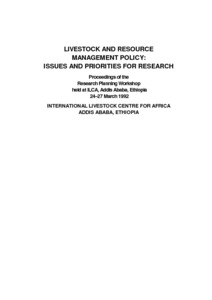Location
Vision, mission and strategy
ILRI's strategy 2013-2022 was approved in December 2012. It emerged from a wide processof consultation and engagement.
ILRI envisions... a world where all people have access to enough food and livelihood options to fulfil their potential.
ILRI’s mission is... to improve food and nutritional security and to reduce poverty in developing countries through research for efficient, safe and sustainable use of livestock—ensuring better lives through livestock.
ILRI’s three strategic objectives are:
- with partners, to develop, test, adapt and promote science-based practices that—being sustainable and scalable—achieve better lives through livestock.
- with partners,to provide compelling scientific evidence in ways that persuade decision-makers—from farms to boardrooms and parliaments—that smarter policies and bigger livestock investments can deliver significant socio-economic, health and environmental dividends to both poor nations and households.
- with partners,to increase capacity among ILRI’s key stakeholders to make better use of livestock science and investments for better lives through livestock.
This is ILRI’s second ten-year strategy. It incorporates a number of changes, many based on learning from the previous strategy (2000–2010, initially produced in 2000 and modified in 2002), an interim strategy (2011–2012) and an assessment of the external and internal environments in which the institute operates.
Members:
Resources
Displaying 986 - 990 of 1152Small ruminant research and development in Africa: Proceedings of the Second Biennial Conference of the African Small Ruminant Research Network, AICC, Arusha, Tanzania, 7-11 December 1992
This volume contains papers and abstracts of the Second Biennial Conference of the African Small Ruminant Network. In addition to the keynote address, there are nine papers on Small Ruminant Production Systems, Economics and Policy, nine papers on Small Ruminant Performance and Reproduction, ten papers on Small Ruminant Health and Reproductive Wastage, eight papers on Small Ruminant Feeds and Feeding Systems and eight papers on Small Ruminant Genetic Resources and Breeding. Ten poster abstracts covering the above topics add to the volume.
Research on cow traction in Africa: Some lessons to be learnt
This paper compares the conclusions drawn from ILCA's work on single-ox and cow traction in Africa with those drawn from surveys and farmers' experience in South East Asia especially Thailand and Bangladesh. The ILCA work shows cow traction to be apparently more profitable than single-ox ploughing and both better than pair-ox ploughing. This paper throws some doubt on these conclusions and indicates that cow traction may cause problems by requiring larger amounts of high quality feed.
Research for development of animal traction in West Africa. Proceedings of the fourth workshop of the West African Animal Traction Network
The report is divided in 12 sections. The first section is introductory. The second section presents research on animal health of working animals. Diversified uses of animal traction including animal-powered rice-huller, weed control are discussed in the 3rd section. The fourth section looks into harnessing and implements used in the different regions of West Africa. The management and nutrition of working animals is discussed in the fifth and sixth sections.
Policy issues and priorities for ILCA technology research
Animal agriculture can add to agricultural development through income generation, intensification, foreign exchange earnings and non-agricultural development. The primary justification for being concerned with animal agricultural in sub-Saharan Africa at present is the need to increase farmer incomes. Technological change is the primary means of raising farmer incomes. However, while new technology is a necessary ingredient in the process of agircultural development, it is not sufficient without conductive policy.
Nutrient management
Vertisols and soils with vertic properties are an important soil group in the Ethiopian highlands. Poor drainage, soil, water and nutrient erosion are the most serious problems on highland Vertisols. Due to their high moisture- storage capacity, they have high production potential and this potential remains underutilised because of the difficulty of managing these soils. This paper summarises available information on chemical properties, N, P and mineralogy.






